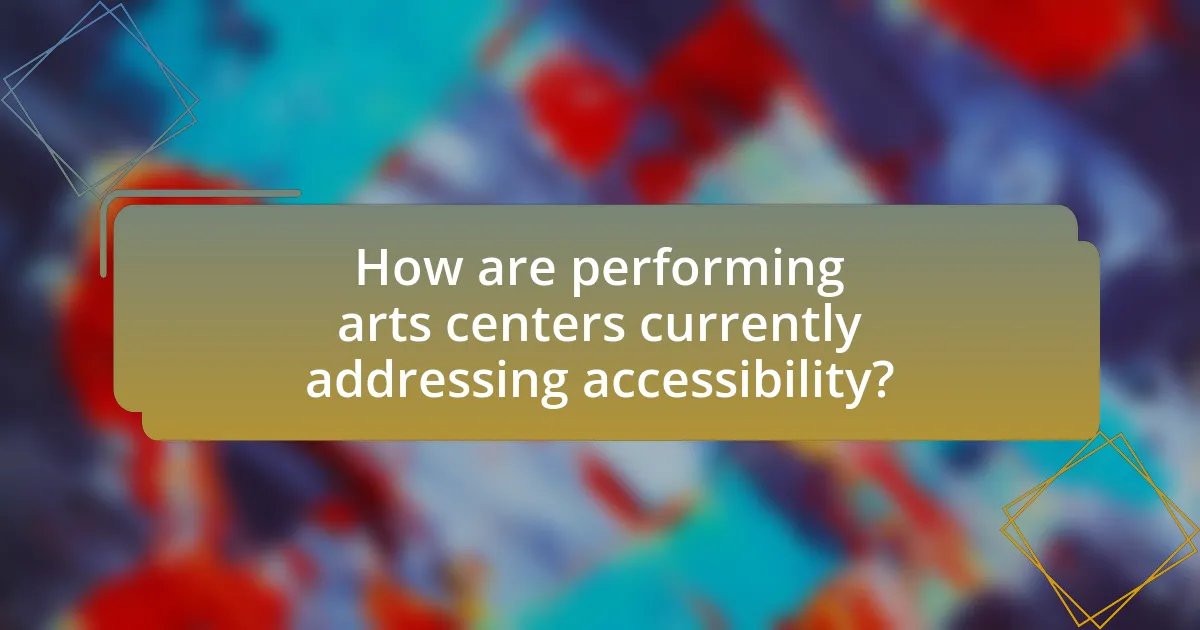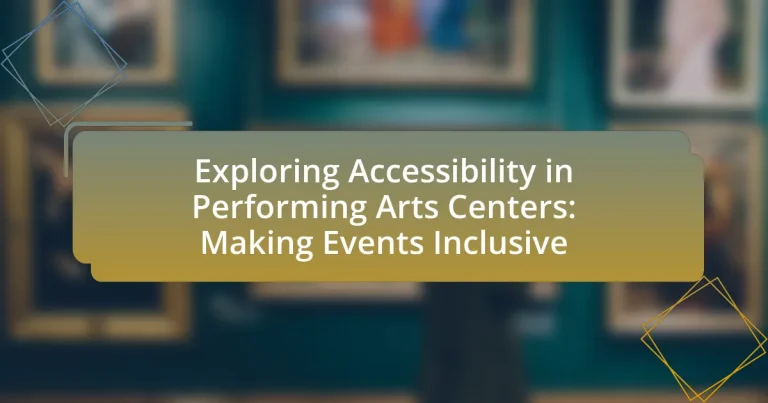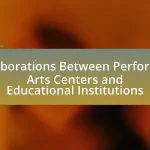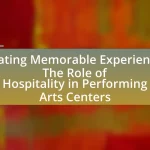Accessibility in Performing Arts Centers encompasses the design and implementation of facilities, services, and programs that enable individuals with disabilities to fully participate in cultural events. Key components include physical access, sensory accommodations, and programmatic inclusivity, all of which are essential for compliance with the Americans with Disabilities Act (ADA). The article examines the importance of accessibility in enhancing audience experience, the legal requirements for performing arts venues, and the challenges faced in implementing effective accessibility measures. It also explores innovative solutions, community engagement strategies, and best practices that can improve accessibility, ultimately fostering a more inclusive environment for diverse audiences.

What is Accessibility in Performing Arts Centers?
Accessibility in Performing Arts Centers refers to the design and implementation of facilities, services, and programs that enable individuals with disabilities to participate fully in cultural events. This includes features such as wheelchair ramps, accessible seating, sign language interpretation, and assistive listening devices. According to the Americans with Disabilities Act (ADA), public venues must provide equal access to all patrons, ensuring that barriers are removed and accommodations are made to support diverse audiences.
Why is accessibility important in the performing arts?
Accessibility is important in the performing arts because it ensures that all individuals, regardless of ability, can participate in and enjoy cultural experiences. By implementing accessible features such as wheelchair ramps, sign language interpretation, and audio descriptions, performing arts venues can accommodate diverse audiences. According to the National Endowment for the Arts, approximately 20% of adults in the U.S. have a disability, highlighting the necessity for inclusive practices to reach a broader audience and foster community engagement. Ensuring accessibility not only complies with legal standards, such as the Americans with Disabilities Act, but also enriches the cultural landscape by promoting diversity and inclusion within the arts.
What are the legal requirements for accessibility in performing arts centers?
The legal requirements for accessibility in performing arts centers are primarily governed by the Americans with Disabilities Act (ADA), which mandates that public venues must be accessible to individuals with disabilities. This includes ensuring that facilities are designed to accommodate wheelchair users, providing accessible seating, restrooms, and entrances, as well as offering assistive listening devices and services for individuals with hearing impairments. Compliance with the ADA is enforced by the Department of Justice, and failure to meet these requirements can result in legal action and penalties. Additionally, the Architectural Barriers Act requires that federally funded facilities also adhere to accessibility standards, reinforcing the necessity for performing arts centers to prioritize inclusivity in their design and operations.
How does accessibility enhance audience experience?
Accessibility enhances audience experience by ensuring that all individuals, regardless of their physical or cognitive abilities, can fully engage with performances and events. When venues implement features such as wheelchair ramps, assistive listening devices, and captioning services, they create an inclusive environment that allows diverse audiences to participate equally. Research indicates that accessible design not only improves satisfaction among attendees with disabilities but also enriches the overall experience for all audience members by fostering a sense of community and belonging. For instance, a study by the National Endowment for the Arts found that inclusive practices in performing arts significantly increase attendance and audience diversity, demonstrating that accessibility is crucial for enhancing the overall experience.
What are the key components of accessibility in performing arts centers?
The key components of accessibility in performing arts centers include physical access, sensory accommodations, and programmatic inclusivity. Physical access involves features such as wheelchair ramps, accessible seating, and restrooms designed for individuals with disabilities. Sensory accommodations may include assistive listening devices, captioning services, and sensory-friendly performances tailored for individuals with sensory sensitivities. Programmatic inclusivity ensures that marketing materials, ticketing processes, and staff training are designed to welcome and support diverse audiences, including those with disabilities. These components collectively enhance the experience for all patrons, ensuring compliance with regulations like the Americans with Disabilities Act, which mandates accessibility standards in public venues.
What physical accommodations should be made for accessibility?
Physical accommodations for accessibility in performing arts centers should include wheelchair ramps, accessible seating, and designated parking spaces. Wheelchair ramps ensure that individuals with mobility impairments can enter and navigate the venue easily, while accessible seating provides adequate space and sightlines for those using wheelchairs or other mobility devices. Designated parking spaces close to the entrance further enhance accessibility by reducing the distance individuals must travel to enter the facility. According to the Americans with Disabilities Act (ADA), these accommodations are not only recommended but required to ensure equal access to public spaces for individuals with disabilities.
How can technology improve accessibility in performing arts events?
Technology can improve accessibility in performing arts events by providing tools such as assistive listening devices, captioning services, and virtual reality experiences. These technologies enable individuals with hearing, visual, or mobility impairments to engage fully with performances. For instance, assistive listening devices enhance audio clarity for those with hearing loss, while real-time captioning allows deaf or hard-of-hearing attendees to follow dialogue and lyrics. Additionally, virtual reality can create immersive experiences for individuals unable to attend in person, broadening access to performances. According to a study by the National Endowment for the Arts, implementing such technologies can significantly increase attendance and participation among people with disabilities, demonstrating their effectiveness in making events more inclusive.

How are performing arts centers currently addressing accessibility?
Performing arts centers are currently addressing accessibility by implementing various measures such as physical modifications, technology enhancements, and inclusive programming. These centers are installing ramps, elevators, and accessible seating to ensure that individuals with mobility challenges can navigate the venues easily. Additionally, many are incorporating assistive listening devices and captioning services to support patrons with hearing impairments. According to the National Endowment for the Arts, 28% of arts organizations have adopted accessibility policies, reflecting a growing commitment to inclusivity in the arts.
What strategies are being implemented to improve accessibility?
Strategies being implemented to improve accessibility in performing arts centers include the installation of assistive technologies, such as hearing loops and audio description services, as well as the design of physical spaces to accommodate individuals with mobility challenges. These measures ensure that events are inclusive for all attendees. For instance, the National Endowment for the Arts reported that venues adopting these technologies have seen increased attendance from individuals with disabilities, demonstrating the effectiveness of such strategies in enhancing accessibility.
How do performing arts centers assess their current accessibility status?
Performing arts centers assess their current accessibility status through comprehensive evaluations that include physical audits, stakeholder feedback, and compliance with legal standards. These evaluations typically involve examining facilities for wheelchair access, seating arrangements, and restroom accessibility, ensuring they meet guidelines set by the Americans with Disabilities Act (ADA). Additionally, centers often conduct surveys and focus groups with patrons who have disabilities to gather insights on their experiences and identify areas for improvement. This multifaceted approach allows performing arts centers to create a more inclusive environment and enhance the overall accessibility of their events.
What role do staff training and awareness play in accessibility efforts?
Staff training and awareness are crucial in accessibility efforts as they equip personnel with the knowledge and skills necessary to assist individuals with disabilities effectively. Trained staff can identify and address accessibility barriers, ensuring that all patrons have equal access to facilities and services. For instance, a study by the National Endowment for the Arts found that organizations with comprehensive staff training programs reported higher satisfaction rates among patrons with disabilities, highlighting the direct impact of informed staff on the overall accessibility experience.
What challenges do performing arts centers face in becoming more accessible?
Performing arts centers face several challenges in becoming more accessible, including financial constraints, structural limitations, and a lack of awareness about accessibility needs. Financial constraints often hinder the ability to implement necessary modifications, such as installing ramps or improving seating arrangements. Structural limitations arise from existing buildings that may not easily accommodate accessibility upgrades, making compliance with regulations like the Americans with Disabilities Act (ADA) difficult. Additionally, a lack of awareness among staff and management about the specific needs of individuals with disabilities can lead to inadequate services and programming, further complicating efforts to create an inclusive environment.
How do budget constraints impact accessibility initiatives?
Budget constraints significantly limit the scope and effectiveness of accessibility initiatives in performing arts centers. When financial resources are restricted, organizations often prioritize essential operational costs over investments in accessibility features such as ramps, audio descriptions, or sign language interpretation. For instance, a study by the National Endowment for the Arts found that only 28% of arts organizations reported having adequate funding to implement comprehensive accessibility measures. This lack of funding can lead to inadequate facilities and services, ultimately excluding individuals with disabilities from fully participating in cultural events.
What are common misconceptions about accessibility in the arts?
Common misconceptions about accessibility in the arts include the belief that accessibility only pertains to physical spaces, that it is solely the responsibility of the venue, and that it is an added expense rather than a necessary investment. Accessibility encompasses a wide range of considerations, including sensory, cognitive, and digital access, not just physical accommodations like ramps or elevators. Furthermore, while venues play a crucial role, creating an inclusive environment requires collaboration among artists, audiences, and community organizations. Research indicates that inclusive practices can enhance audience engagement and broaden the reach of arts organizations, demonstrating that accessibility is not merely an expense but a strategic advantage for fostering diverse participation.

What best practices can enhance accessibility in performing arts centers?
Best practices that can enhance accessibility in performing arts centers include implementing physical modifications, providing assistive technologies, and offering staff training on accessibility awareness. Physical modifications such as installing ramps, accessible seating, and restrooms ensure that individuals with mobility impairments can navigate the venue comfortably. The use of assistive technologies, like hearing loops and captioning services, facilitates participation for those with hearing and visual impairments. Additionally, training staff on accessibility protocols fosters an inclusive environment, as informed personnel can better assist patrons with diverse needs. These practices collectively contribute to a more inclusive experience for all attendees.
How can performing arts centers engage with the community to improve accessibility?
Performing arts centers can engage with the community to improve accessibility by implementing outreach programs that involve local stakeholders in decision-making processes. These centers can host community forums to gather input on accessibility needs, ensuring that performances and facilities cater to diverse audiences, including individuals with disabilities. Research indicates that when arts organizations actively involve community members, they can better identify barriers and develop tailored solutions, such as offering sensory-friendly performances or providing assistive technologies. For instance, a study by the National Endowment for the Arts found that inclusive practices not only enhance audience engagement but also increase attendance among underrepresented groups.
What feedback mechanisms can be established to gather audience insights on accessibility?
To gather audience insights on accessibility, performing arts centers can establish multiple feedback mechanisms such as surveys, focus groups, and accessibility audits. Surveys can be distributed post-event to collect quantitative data on audience experiences, while focus groups can provide qualitative insights through in-depth discussions with diverse audience members. Accessibility audits, conducted by trained professionals, can evaluate the physical and digital environments, ensuring they meet accessibility standards. Research indicates that organizations that actively seek feedback through these methods can improve their services and enhance audience satisfaction, as evidenced by a study from the National Endowment for the Arts, which found that inclusive practices lead to increased attendance and engagement.
How can partnerships with disability organizations enhance accessibility efforts?
Partnerships with disability organizations can significantly enhance accessibility efforts by providing expert insights and resources tailored to the needs of individuals with disabilities. These organizations often have firsthand experience and knowledge about the specific barriers faced by disabled individuals, which can inform the design and implementation of more effective accessibility measures. For instance, collaboration with organizations such as the National Organization on Disability has led to improved physical access, communication methods, and programming that better serve diverse audiences. By leveraging the expertise of these organizations, performing arts centers can create more inclusive environments, ensuring that events are accessible to all attendees, thereby increasing participation and engagement.
What innovative solutions are being explored for accessibility in the arts?
Innovative solutions being explored for accessibility in the arts include the use of augmented reality (AR) for enhancing visual experiences and the implementation of audio description technologies for visually impaired audiences. These technologies allow for real-time information delivery, improving engagement and understanding of performances. For instance, the National Theatre in London has adopted AR applications that provide visual cues and descriptions, making productions more accessible. Additionally, organizations are developing mobile apps that offer sign language interpretation and captioning, further broadening access for deaf and hard-of-hearing individuals. These advancements demonstrate a commitment to inclusivity in the arts, ensuring that diverse audiences can participate fully in cultural experiences.
How can virtual and augmented reality contribute to inclusive experiences?
Virtual and augmented reality can significantly contribute to inclusive experiences by providing immersive environments that cater to diverse needs. These technologies enable individuals with disabilities to engage with performances and events in ways that traditional formats may not allow. For instance, virtual reality can simulate environments that accommodate sensory sensitivities, while augmented reality can enhance real-time information access, such as subtitles or sign language interpretation, directly within the user’s field of vision. Research indicates that 70% of users with disabilities reported improved engagement in events when utilizing these technologies, demonstrating their effectiveness in fostering inclusivity.
What role does audience participation play in shaping accessible events?
Audience participation is crucial in shaping accessible events as it directly influences the design and implementation of inclusive practices. Engaging the audience allows event organizers to gather feedback on accessibility needs, ensuring that facilities, programs, and services cater to diverse audiences. For instance, research by the National Endowment for the Arts indicates that events with active audience involvement report higher satisfaction rates and increased attendance from individuals with disabilities. This feedback loop fosters an environment where accessibility is prioritized, leading to more effective adaptations and innovations in event planning.
What practical steps can performing arts centers take to improve accessibility?
Performing arts centers can improve accessibility by implementing physical modifications, enhancing communication, and providing training. Physical modifications include installing ramps, elevators, and accessible seating to accommodate individuals with mobility challenges. Enhancing communication involves offering materials in multiple formats, such as braille and large print, and providing sign language interpreters during performances. Additionally, training staff on disability awareness and customer service can create a more inclusive environment. According to the National Endowment for the Arts, making these changes can significantly increase attendance from individuals with disabilities, demonstrating the importance of accessibility in fostering an inclusive arts community.


